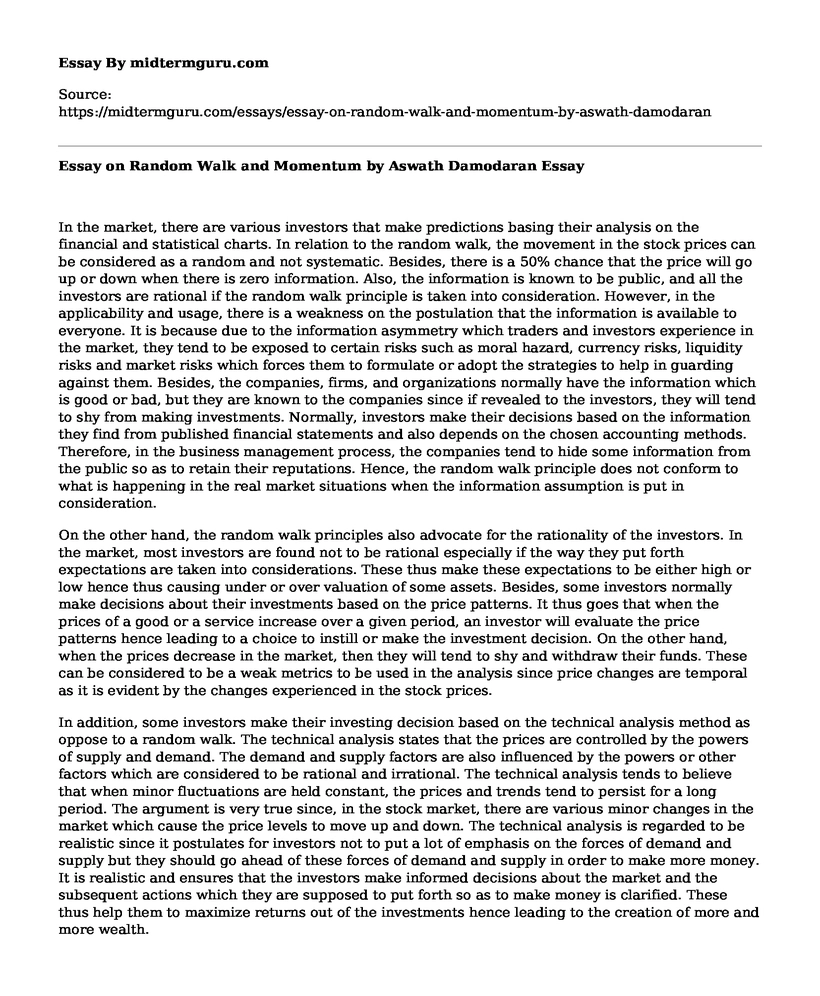In the market, there are various investors that make predictions basing their analysis on the financial and statistical charts. In relation to the random walk, the movement in the stock prices can be considered as a random and not systematic. Besides, there is a 50% chance that the price will go up or down when there is zero information. Also, the information is known to be public, and all the investors are rational if the random walk principle is taken into consideration. However, in the applicability and usage, there is a weakness on the postulation that the information is available to everyone. It is because due to the information asymmetry which traders and investors experience in the market, they tend to be exposed to certain risks such as moral hazard, currency risks, liquidity risks and market risks which forces them to formulate or adopt the strategies to help in guarding against them. Besides, the companies, firms, and organizations normally have the information which is good or bad, but they are known to the companies since if revealed to the investors, they will tend to shy from making investments. Normally, investors make their decisions based on the information they find from published financial statements and also depends on the chosen accounting methods. Therefore, in the business management process, the companies tend to hide some information from the public so as to retain their reputations. Hence, the random walk principle does not conform to what is happening in the real market situations when the information assumption is put in consideration.
On the other hand, the random walk principles also advocate for the rationality of the investors. In the market, most investors are found not to be rational especially if the way they put forth expectations are taken into considerations. These thus make these expectations to be either high or low hence thus causing under or over valuation of some assets. Besides, some investors normally make decisions about their investments based on the price patterns. It thus goes that when the prices of a good or a service increase over a given period, an investor will evaluate the price patterns hence leading to a choice to instill or make the investment decision. On the other hand, when the prices decrease in the market, then they will tend to shy and withdraw their funds. These can be considered to be a weak metrics to be used in the analysis since price changes are temporal as it is evident by the changes experienced in the stock prices.
In addition, some investors make their investing decision based on the technical analysis method as oppose to a random walk. The technical analysis states that the prices are controlled by the powers of supply and demand. The demand and supply factors are also influenced by the powers or other factors which are considered to be rational and irrational. The technical analysis tends to believe that when minor fluctuations are held constant, the prices and trends tend to persist for a long period. The argument is very true since, in the stock market, there are various minor changes in the market which cause the price levels to move up and down. The technical analysis is regarded to be realistic since it postulates for investors not to put a lot of emphasis on the forces of demand and supply but they should go ahead of these forces of demand and supply in order to make more money. It is realistic and ensures that the investors make informed decisions about the market and the subsequent actions which they are supposed to put forth so as to make money is clarified. These thus help them to maximize returns out of the investments hence leading to the creation of more and more wealth.
It can thus be said that the technical analysis and the random walk methods to investments are key in giving a direction in which people can take so as to achieve the set objectives. However, when carrying out comparisons between the two metrics, the technical analysis carries the day since its assumptions approach the market in a more practical manner as compared to random walk method. It is because the random walk states that there is no information asymmetry, but most people due to lack of enough knowledge lose billions of cash when they invest in the stock market. However, in the analysis of the market based on the technical analysis, the assumptions which hold the minor changes of the prices in the financial market are held constant should be relaxed. It is because, in the stock, money or good market, the success of an investor is bestowed on the minor decisions they make before, during and after the investment processes. Therefore, it is evident that before investing in the stock market, an investor should consider various market forces and make a rational decision based on an identified most successful metric. These will help to minimize the degree of exposure to risks hence maximizing profit levels.
Cite this page
Essay on Random Walk and Momentum by Aswath Damodaran. (2021, Jun 18). Retrieved from https://midtermguru.com/essays/essay-on-random-walk-and-momentum-by-aswath-damodaran
If you are the original author of this essay and no longer wish to have it published on the midtermguru.com website, please click below to request its removal:
- Rhetorical Analysis on the Banking Concept of Education
- Accounts Payable Turnover Ratio for National Central Cooling Company
- Paper Example on Pros and Cons of National Health Insurance
- Soliciting 5000 Dollars Training Grant Paper Example
- The Cost of Capital - Paper Example
- Central Bank of Egypt and the United States - Compare and Contrast Essay
- China's Economic Growth - Essay Sample







